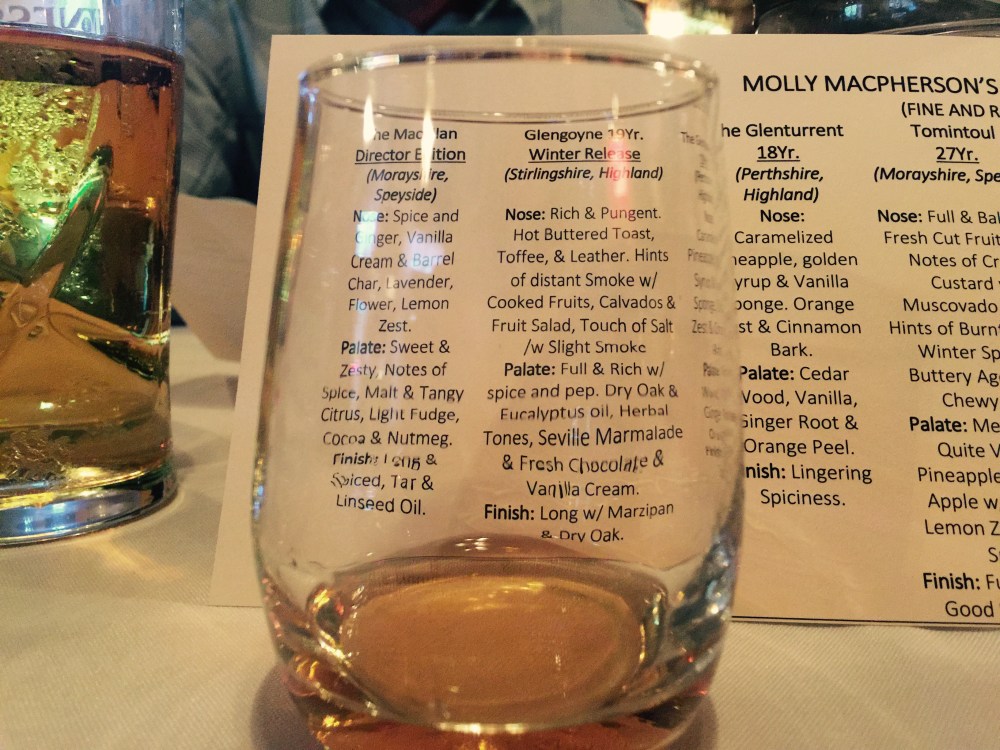The Case for Drinking Scotch in Savannah

When John Hendrick, the General Manger of downtown’s Molly MacPherson’s Scottish Pub, invites you to a small private Scotch Whisky tasting, you don’t turn it down. Period. It doesn’t matter that it’s on a Monday night. It doesn’t even matter that its $150 per person. You find space on your credit card. Your kids aren’t going to practice tonight. You find a babysitter. You bribe them with pizza and a quality viewing of the 1985 classic “The Goonies.” Don’t waste your time worrying about “responsibilities” (whatever that is). You must drop everything. You must stay focused.
This is not the ramblings of an alcoholic. Second only to perhaps wine in terms of how geeked out people get over an adult drink, whisky – especially good whisky – is supremely important. It is not only a contemplative drink with sophisticated palatable layers and endless expressions that somehow all relate to each other, but it is also a symbol of a proud heritage – Savannah’s heritage. Or at least it should be.
Confession: we not only have an inappropriate love affair with Scotch Whisky, but we are also Scottish. Our parents were raised in Edinburgh. I was born in England shortly after my family moved from Scotland to just outside London. Most of our family – cousins, aunts, uncles and once again our parents – still live there. And yes, we are therefore biased on this subject. But that does not necessarily make our point any less valid. Savannah should officially adopt a symbol to recognize the contributions from the Scots and the influence those peoples have had on this great city.
It started shortly after Oglethorpe founded Savannah in 1733. The Trustee’s of the soon to be great port city enlisted the help of over 100 Scottish Highlanders to be the first guardians of Savannah. The would-be Revolutionary War Hero, Lachlan MacIntosh was only a teenage lad when he arrived on board that ship. These extremely effective warriors brought more than just their might. They brought their culture and their culinary heritage, too.
There are a few instances where one might be able to see the Scots’ culinary influence in the area even today, though we have rarely heard it discussed outside of our Savannah Taste Experience Food Tours. One of Savannah’s and the Lowcountry’s most notable contributions to world cuisine – she-crab soup or crab stew – was originally known as “Parten Bree”. And yes, it was the Scots who brought the dish with them in the mid-1700s.
Beyond food, the Scots influence and importance in Savannah’s history is undeniable. Andrew Low – wealthy cotton dealer and father-in-law to Girl Scout’s founder, Juliette Gordon Low – was only 16 years old when he left Scotland and would become one of the wealthiest and most influential Savannahians of his time. Scottish-born and raised Edward Telfair would not only be a member of the Continental Congress, Signor of the Articles of Confederation and a 3-time governor of the new State of Georgia, but would also be the father of one of Savannah’s most cherished philanthropists, Mary Telfair. And the list goes on.
So Scotch in Savannah makes sense. I further argue that Scotch as a symbol of the Scottish influence on Savannah is perfect. Right? Let’s not get bogged down in details such as the fact that the oldest whisky distillery in Scotland was arguably founded in 1775 – a full 40-plus years from the arrival of the first Scots to Savannah – Scots who according to those numbers never would have tasted Scotch in their life. Details shmetails.
The point is that there is a lot of Scottish influence in Savannah, but other than the small marker on Oglethorpe Avenue (a very busy street these days) there are no monuments or even symbols where our residents and our guests can go to contemplate our Scottish ancestors. Why not let it be Scotch? Scotch is something to be enjoyed slowly. It’s just not a fast drink. It takes years to make. It takes the patience of swishing around on your palate to be able to fully realize all of the complexities of her broth.
You simply can’t rush Scotch, just as you wouldn’t rush through Monterey Square on your way to Forsyth. You should slowly sip your wee dram and meditate on the nose, the layers of flavor, the texture and the finish of each drop, just as you should sit on a bench in the cool shade of Lafayette Square and meditate on the breeze, the greenery, and awesome beauty of this city. Indeed to fully enjoy either Scotch or Savannah, one must slow the hell down and pay attention to the details.
If not Scotch, why not let the official symbol of Scottish Heritage in Savannah be Molly MacPherson’s Scottish Pub? The pub may only have been in Savannah since 2005, but it is the only place still serving great traditional Scottish food in the Historic District that would have been eaten by the warrior guardians of Savannah. It also has the best selection of single malt scotches and other whiskies than anywhere in Savannah . . . than Georgia . . . than arguably the entire east coast. And it makes perfect sense that there are more whiskies here than anywhere else in a several-days drive – Savannah has the Scottish heritage and enjoys slow reflective meditations better than almost anywhere.
So on Monday, August 15th, 2016, I sat down with my wife, my youngest brother and a dozen other strangers and drank some of the finest expressions of whisky I have ever enjoyed. All of the whiskies were rare. Most of them cost several hundred dollars a bottle. Some of them are even in such short supply that collectors now have to auction for them.
We drank them slowly. We contemplated the aromas. We debated whether each expression had hints of apricots or traces of golden syrup or had a finish of fine American Oak. And we did it in Savannah in a beautifully simple and nostalgic Scottish pub eating Haggis, Neeps and Tatties. All as God intended.
